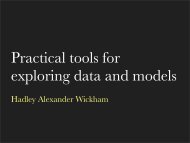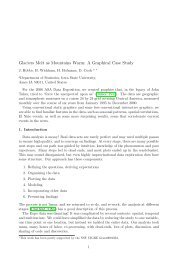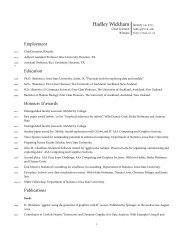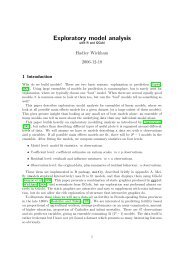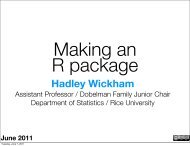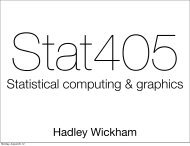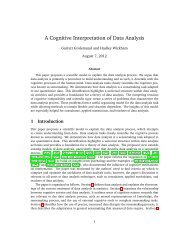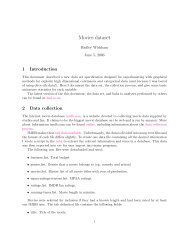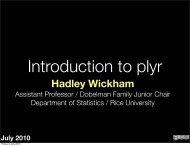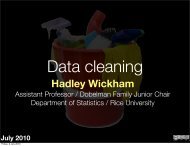Statistical inference for exploratory data analysis ... - Hadley Wickham
Statistical inference for exploratory data analysis ... - Hadley Wickham
Statistical inference for exploratory data analysis ... - Hadley Wickham
Create successful ePaper yourself
Turn your PDF publications into a flip-book with our unique Google optimized e-Paper software.
4370 A. Buja et al.<br />
one feels different but I cannot put my finger on why this is so’. This is a<br />
possibility in principle, but usually the viewer will be eager to justify his<br />
or her selection by identifying a feature with regard to which the selected<br />
plot stands out compared to the rest.<br />
(ii) This protocol can be self-administered by the <strong>data</strong> analyst once, if he or<br />
she writes code that inserts the plot of the real <strong>data</strong> among the 19 null<br />
plots randomly in such a way that its location is not known to the <strong>data</strong><br />
analyst. A second round of self-administration of the protocol by the <strong>data</strong><br />
analyst will not be inferentially valid because the analyst will not only<br />
have seen the plot of the real <strong>data</strong> but in all likelihood have (inadvertently)<br />
memorized some of its idiosyncrasies, which will make it stand out to the<br />
analyst even if the real <strong>data</strong> <strong>for</strong>m a sample from the null hypothesis.<br />
(iii) Some variations of the protocol are possible whereby investigators are<br />
asked to select not one but two or more ‘most special’ plots or rank them<br />
completely or partially, with p-values obtained from methods appropriate<br />
<strong>for</strong> ranked and partially ranked <strong>data</strong>.<br />
(iv) This protocol can be repeated with multiple independently recruited<br />
viewers who have not seen the plot of the real <strong>data</strong> previously, and the<br />
p-value can thereby be sharpened by tabulating how many independent<br />
investigators picked the plot of the real <strong>data</strong> from among 19 null plots.<br />
If K investigators are employed and k (k ≤ K) selected the plot of the real<br />
<strong>data</strong>, the combined p-value is obtained as the tail probability P(X ≤ k) of<br />
a binomial distribution B(K, p = 1/20). It can hence be as small as 0.05 K<br />
if all investigators picked the plot of the real <strong>data</strong> (k = K).<br />
The idea of the lineup protocol is alluded to by §7 of Davies (2008) to illustrate<br />
his idea of models as approximations. He proposes the following principle:<br />
‘P approximates xn if <strong>data</strong> generated under P look like xn’. Davies illustrates<br />
with a univariate example where a boxplot of the real <strong>data</strong> is indistinguishable<br />
from 19 boxplots of Γ(16, 1.2) <strong>data</strong> but stands out when mingled with boxplots<br />
of Γ(16, 1.4) <strong>data</strong>. The ingredient that is missing in Davies (2008) is the general<br />
recommendation that nuisance parameters of the model be dealt with in one of<br />
several possible ways (see electronic supplementary material) and that a protocol<br />
be applied to grant inferential validity.<br />
6. Examples<br />
This section is structured so that readers can test lineup witness skills using the<br />
examples. Following all of the lineups, readers will find solutions and explanations.<br />
We recommend reading through this section linearly. Several of the <strong>data</strong>sets used<br />
in the examples may be familiar, and if so we suggest that the familiarity is a<br />
point of interest because readers who know the <strong>data</strong> may prove to themselves the<br />
disruptive effect of familiarity in light of the protocol.<br />
The first two examples are of plots designed <strong>for</strong> EDA: scatterplots and<br />
histograms. For a scatterplot, the most common null hypothesis is that the two<br />
variables are independent, and thus null <strong>data</strong>sets can be produced by permuting<br />
the values of one variable against the other. Histograms are more difficult.<br />
The simplest null hypothesis is that the <strong>data</strong> are a sample from a normal<br />
Phil. Trans. R. Soc. A (2009)<br />
Downloaded from<br />
rsta.royalsocietypublishing.org on January 7, 2010



